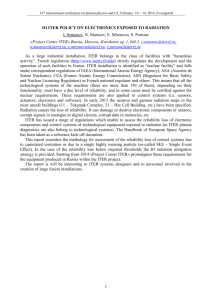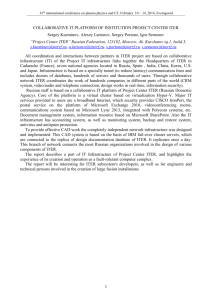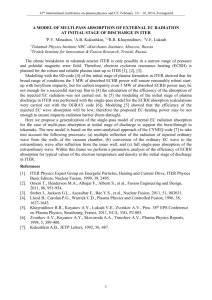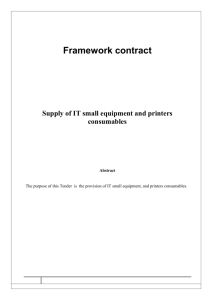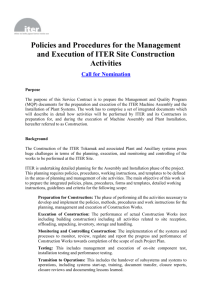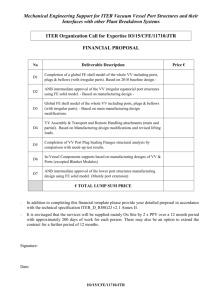22.012 Presentation: ! Materials in ITER and beyond Jill A. Rowehl
advertisement
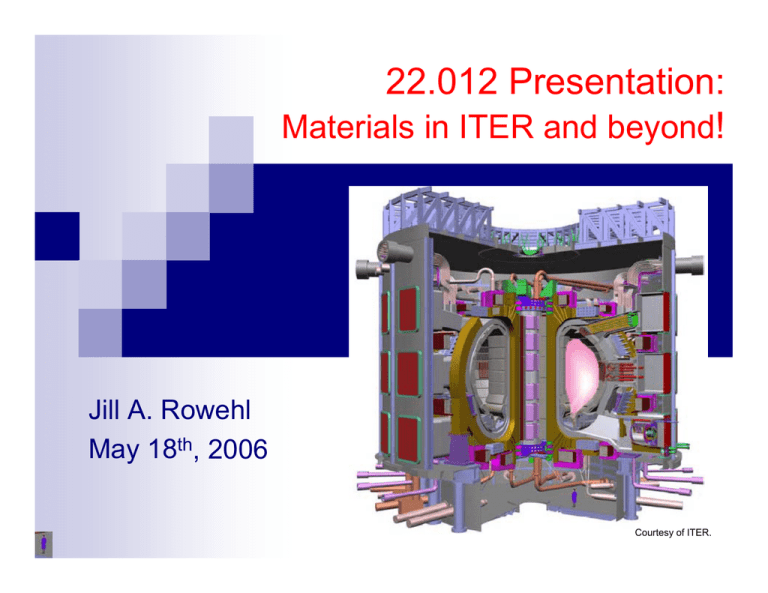
22.012 Presentation: Materials in ITER and beyond! Jill A. Rowehl May 18th, 2006 Courtesy of ITER. Outline Vessel = materials for containing plasma Other random Image removed for Copyright reasons. materials… Components and materials for ITER. From Max Planck Society for Advancement of Science http://www.ipp.mpg.de/ippcms/eng/pr/forschung/iter/ Progress in Materials? Going and going… Vessel Materials: containing the plasma1,2 Must handle high heat loads Steady and disruptions Radiation resistant Long-life (thousands of cycles) Cheap! (not going to happen) Figure removed for copyright reasons. Source: START experiment at UKAEA, Culham. http://www.fusion.org.uk/culham/start.htm Vessel Materials in ITER3 Courtesy of ITER. ITER ITA NEWSLETTER, SEPTEMBER 2003 Vessel Materials in ITER5: ITER First Wall: Be low Z Elevation view of ITER divertor. First used in JET Disadv: Low melting point Courtesy of Sandia National Laboratories. ITER Diverter: Tungsten Disadv: high Z (causes power loss in the plasma) CFC low erosion can take very high heat Erodes faster but can be thicker so lasts longer Materials of the future4: EUROFER alloy: elements have been substituted by more benign elements, e.g. Mo has been replaced by W; Nb by Ta and V. Cr content: optimize corrosion resistance and low embrittlement under neutron irradiation. expected to withstand neutron fluxes up to 150 dpa and an operational temperature range of 300°C to 560°C. For DEMO (life after ITER) A Blanket to Control the Warmth7 to protect other materials from the radiation Cools other ITER components and collects heat To breed tritium fuel (in the second phase of ITER) Overall cannot exceed 5 tons Designed to last 10 years Must be easily removed remotely for maintenance Magnets = Materials6,3 Super large! Super high field! ~13 T They’re already super expensive! High Temp. Superconductors (HTS): T ~ 100K Niobium-Tin will most likely be used ITER toroidal field magnet design Courtesy of the U.S. Office of Fusion Energy Sciences. Still more components made of materials Structural: to keep ITER from falling apart Testing instruments (not to mention that the plasma itself is a material) In Conclusion… Fusion Progress2 Figure removed for copyright reasons. See: graph on page 3 of Reference 2. Materials Progress4 Graph figure removed for Copyright reasons. http://www.iter.org Bibliography 1 = Goldston, Robert. “ITER as a Step to Fusion Power”. Nov 19, 2003, http://fire.pppl.gov/fpa03_goldston.ppt 2 = Fusion Energy: Power for future generations, May 2003, http://wwwfusion.ciemat.es/New_fusion/es/Fusion/documentos/fusionenergy.pdf 3 = ITER ITA NEWSLETTER, Sept 2003, http://wwwpub.iaea.org/MTCD/publications/PDF/Newsletters/ITER-NL-ITA-8.pdf 4 = Bolt, Materials for Fusion, Sept 8, 2004, http://www.mpg.de/pdf/europeanWhiteBook/wb_materials_100_104.pdf 5 = Ulrickson, M. et al., Selection of Plasma Facing Materials for ITER, 1995, http://ieeexplore.ieee.org/iel3/3790/11107/00534250.pdf?arnumber=534250 6 = DOE, The Potential Role of ITER in Magnetic Fusion Energy Research, Feb 3, 2003, http://www.ofes.fusion.doe.gov/ITER/RoleofITERinMFE.pdf 7 = Boeing, ITER Shield Blanket Design, Sept 12, 1997, http://www.boeing.com/assocproducts/hienergy/ITER_SB.htm Thank You!
